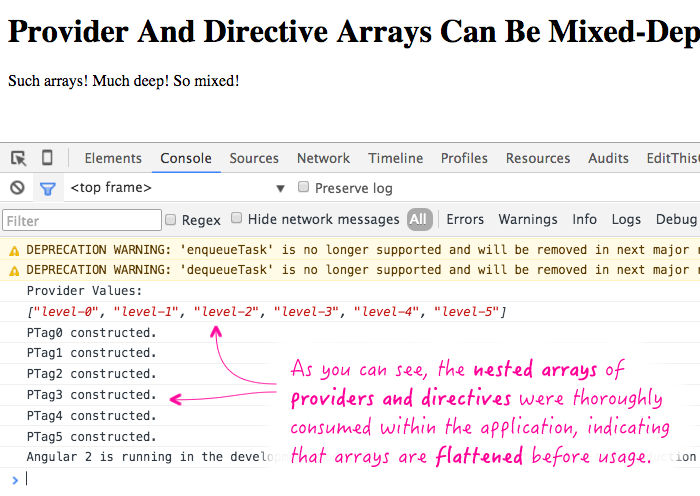Provider And Directive Arrays Can Be Mixed-Depth In Angular 2 Beta 6
Back when I was experimenting with creating an Angular 1.x inspired link function in Angular 2, I demonstrated that you could seamlessly swap one directive reference with an array of directive references. This is a pattern - arrays within arrays - that I have seen in many places throughout the Angular 2 source code. So, I wanted to put together a quick little experiment to see how far such a construct could be taken, specifically with service provider and directives arrays.
Run this demo in my JavaScript Demos project on GitHub.
To play with idea, I tried to provide the Angular 2 application bootstrapper with an increasingly deep set of arrays for a multi:true provider. Then, within the root component, I'm doing something similar with directives - providing an increasingly deep set of arrays for directive classes. The goal of both of these is to log the result to the console so that I can see what as been aggregated by the Angular 2 framework:
<!doctype html>
<html>
<head>
<meta charset="utf-8" />
<title>
Provider And Directive Arrays Can Be Mixed-Depth In Angular 2 Beta 6
</title>
</head>
<body>
<h1>
Provider And Directive Arrays Can Be Mixed-Depth In Angular 2 Beta 6
</h1>
<my-app>
Loading...
</my-app>
<!-- Load demo scripts. -->
<script type="text/javascript" src="../../vendor/angularjs-2-beta/6/es6-shim.min.js"></script>
<script type="text/javascript" src="../../vendor/angularjs-2-beta/6/Rx.umd.min.js"></script>
<script type="text/javascript" src="../../vendor/angularjs-2-beta/6/angular2-polyfills.min.js"></script>
<script type="text/javascript" src="../../vendor/angularjs-2-beta/6/angular2-all.umd.js"></script>
<!-- AlmondJS - minimal implementation of RequireJS. -->
<script type="text/javascript" src="../../vendor/angularjs-2-beta/6/almond.js"></script>
<script type="text/javascript">
// Defer bootstrapping until all of the components have been declared.
// --
// NOTE: Not all components have to be required here since they will be
// implicitly required by other components.
requirejs(
[ "AppComponent" ],
function run( AppComponent ) {
ng.platform.browser.bootstrap(
AppComponent,
// As we define the provider array, notice that we are wrapping each
// multi-value instance in an increasingly deep nested array. This
// way, we can test how much the array will be flattened during the
// bootstrapping process.
[
ng.core.provide(
"VALUE_COLLECTION",
{
useValue: "level-0",
multi: true
}
),
[
ng.core.provide(
"VALUE_COLLECTION",
{
useValue: "level-1",
multi: true
}
)
],
[
[
ng.core.provide(
"VALUE_COLLECTION",
{
useValue: "level-2",
multi: true
}
)
]
],
[
[
[
ng.core.provide(
"VALUE_COLLECTION",
{
useValue: "level-3",
multi: true
}
)
]
]
],
[
[
[
[
ng.core.provide(
"VALUE_COLLECTION",
{
useValue: "level-4",
multi: true
}
)
]
]
]
],
[
[
[
[
[
ng.core.provide(
"VALUE_COLLECTION",
{
useValue: "level-5",
multi: true
}
)
]
]
]
]
]
]
);
}
);
// --------------------------------------------------------------------------- //
// --------------------------------------------------------------------------- //
// I provide the root App component.
define(
"AppComponent",
function registerAppComponent() {
// All of these directives will select against the "p" element.
var PTag0 = require( "PTag0" );
var PTag1 = require( "PTag1" );
var PTag2 = require( "PTag2" );
var PTag3 = require( "PTag3" );
var PTag4 = require( "PTag4" );
var PTag5 = require( "PTag5" );
// Configure the App component definition.
ng.core
.Component({
selector: "my-app",
// As we define the directive array, notice that we are wrapping
// each directive class in an increasingly deep nested array.
// This way, we can test how much the array will be flattened
// during the linking process.
directives: [
PTag0,
[ PTag1 ],
[ [ PTag2 ] ],
[ [ [ PTag3 ] ] ],
[ [ [ [ PTag4 ] ] ] ],
[ [ [ [ [ PTag5 ] ] ] ] ]
],
template:
`
<p>
Such arrays! Much deep! So mixed!
</p>
`
})
.Class({
constructor: AppController
})
;
AppController.parameters = [ new ng.core.Inject( "VALUE_COLLECTION" ) ];
return( AppController );
// I control the App component.
function AppController( values ) {
var vm = this;
// Let's log-out the values that were collected from our mixed-depth
// provider collection.
console.log( "Provider Values:" );
console.log( values );
}
}
);
// --------------------------------------------------------------------------- //
// --------------------------------------------------------------------------- //
// Let's setup several Directives that all select for "P". This way, we can see
// how many of them get instantiated in the App component with the mixed-depth
// directive array.
[ 0, 1, 2, 3, 4, 5 ].forEach(
function iterator( depth ) {
define(
( "PTag" + depth ),
function registerPTag() {
// Configure the PTag directive definition.
// --
// CAUTION: Normally, I wouldn't return the value of this
// method chain. However, I was running into a bug that I didn't
// understand in which the wrong directives were being linked
// if I returned the constructor reference. I'll investigate that
// in a subsequent blog post (if I can figure it out).
return ng.core
.Directive({
selector: "p"
})
.Class({
constructor: function() {
console.log( "PTag" + depth + " constructed." );
}
})
;
}
);
}
);
</script>
</body>
</html>
As you can see, I'm collecting the multi:true provider values and then injecting them into the AppComponent where I'm logging them out. Then, I'm providing multiple directives to the AppComponent, all of which select against "p", and log their own instantiation. And, when we run the above code, we get the following page output:

As you can see, all provider and directive values were picked up in the array, no matter how deeply nested. Clearly, Angular 2 is flattening the arrays before consuming them. This is actually quite a powerful feature because it means that multiple values can be consumed by the calling context without the calling context needing to be aware of the complexity of the collection. In other words, a module can expose a single value that contains multiple values and the consumer of that module doesn't have to know about the implementation details. Very cool!
Want to use code from this post? Check out the license.

Reader Comments